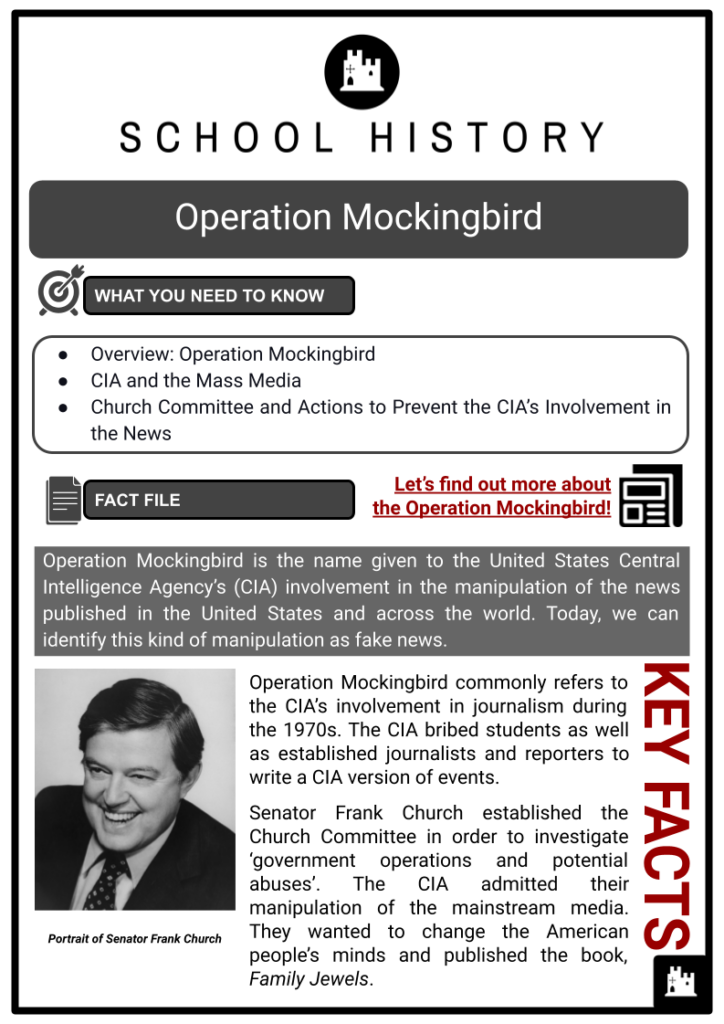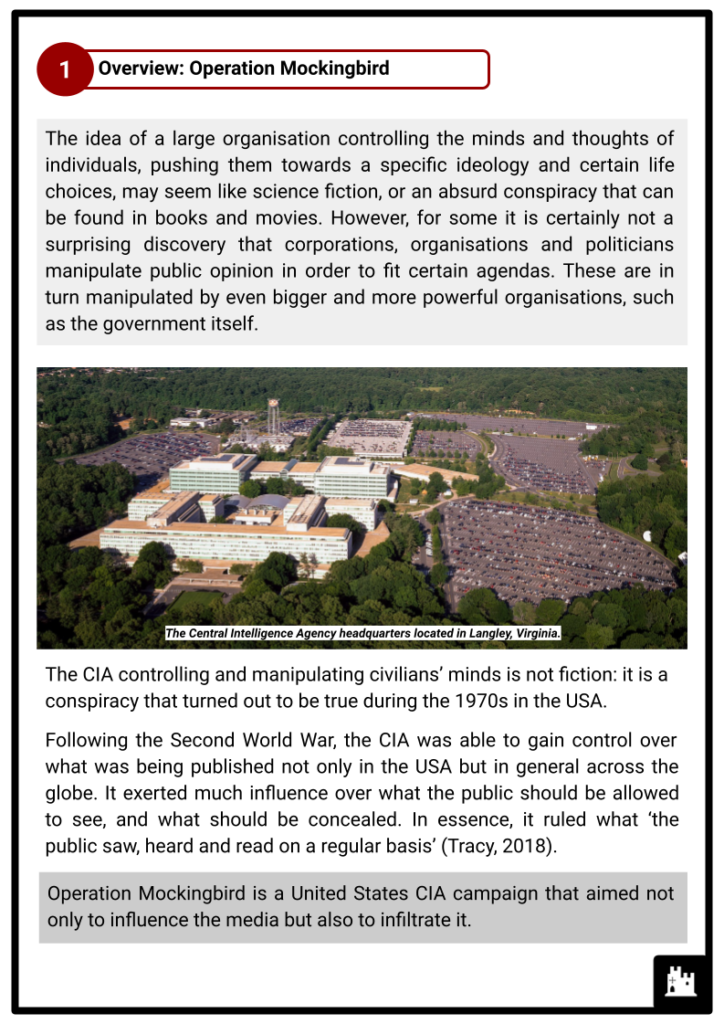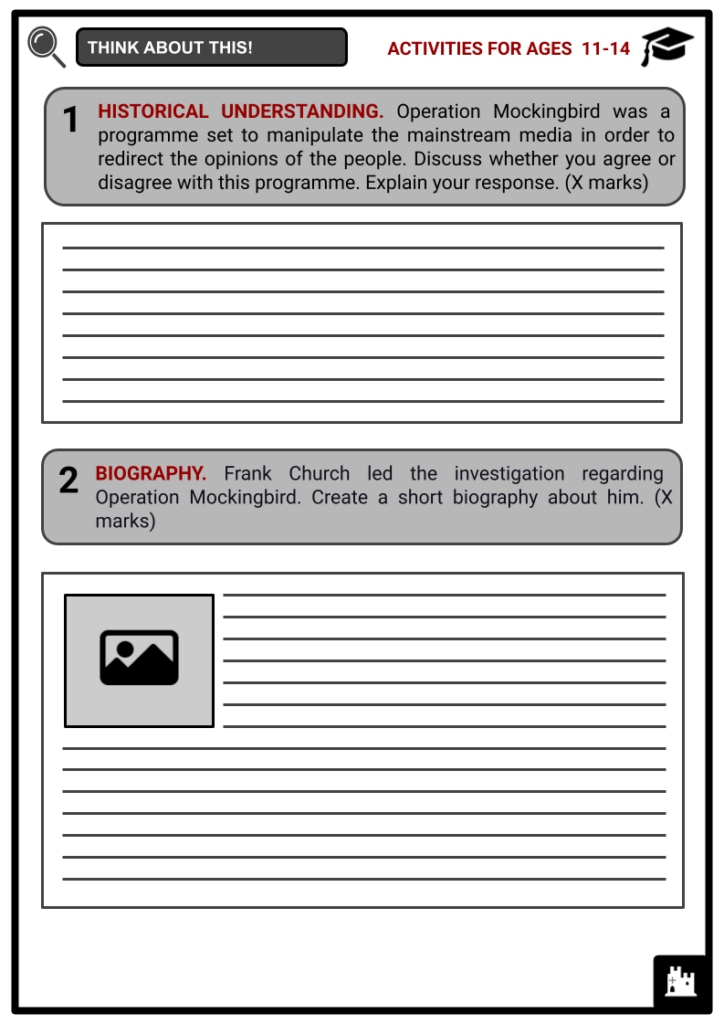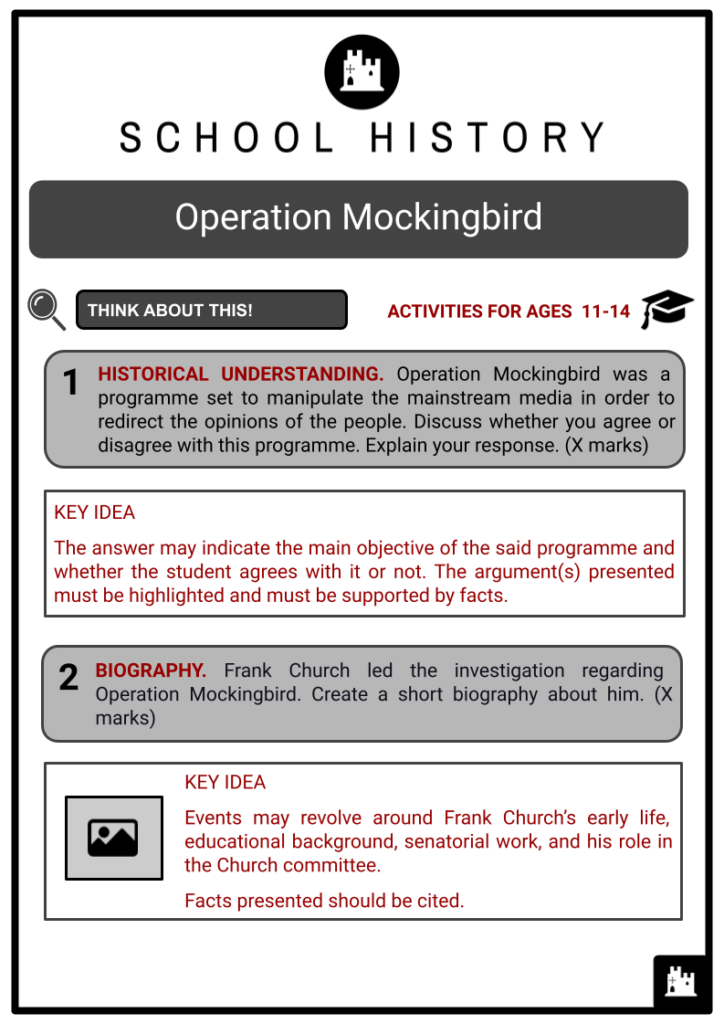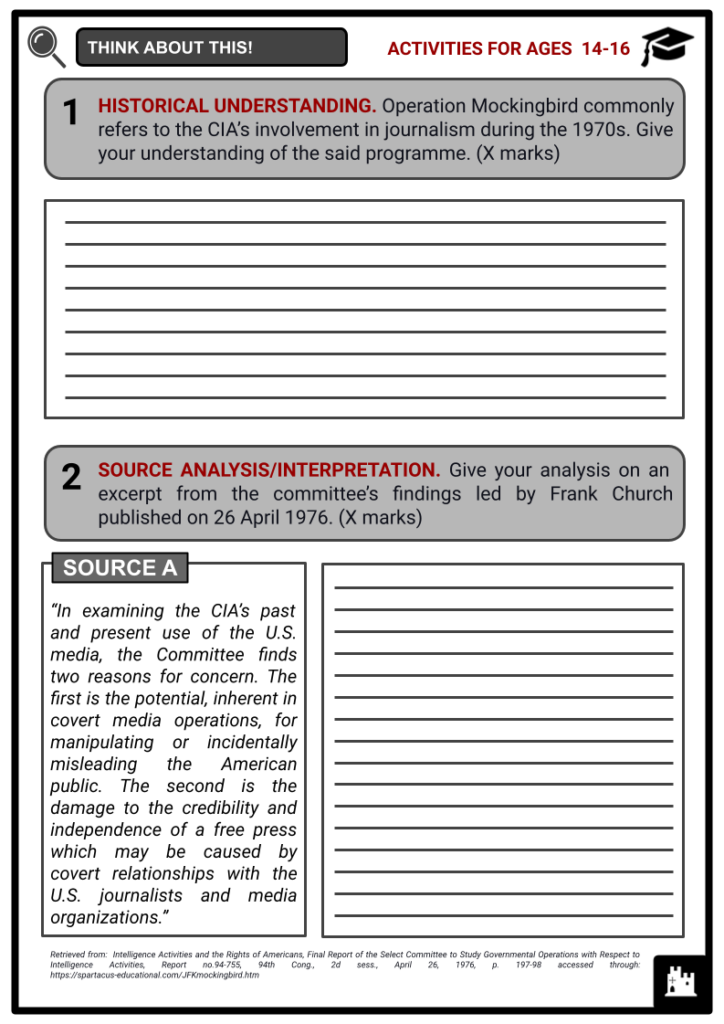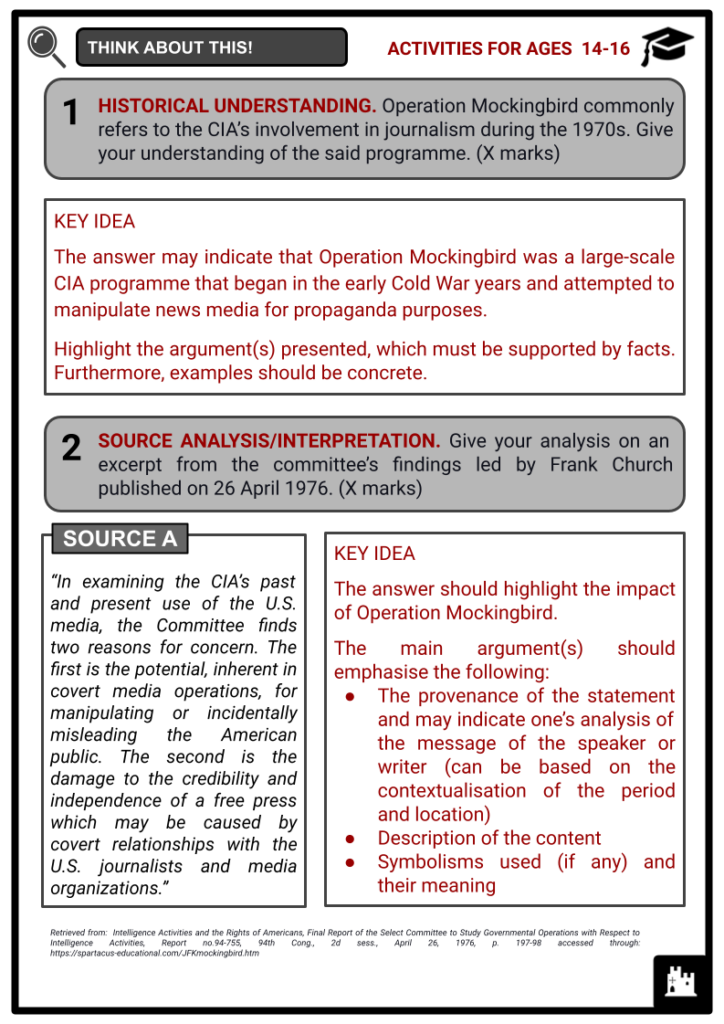Operation Mockingbird Worksheets
Do you want to save dozens of hours in time? Get your evenings and weekends back? Be able to teach about Operation Mockingbird to your students?
Our worksheet bundle includes a fact file and printable worksheets and student activities. Perfect for both the classroom and homeschooling!
Summary
- Overview: Operation Mockingbird
- CIA and the Mass Media
- Church Committee and Actions to Prevent the CIA’s Involvement in the News
Key Facts And Information
Let’s find out more about Operation Mockingbird!
Operation Mockingbird is the name given to the United States Central Intelligence Agency’s (CIA) involvement in the manipulation of the news published in the United States and across the world. Today, we can identify this kind of manipulation as fake news.

Operation Mockingbird commonly refers to the CIA’s involvement in journalism during the 1970s. The CIA bribed students as well as established journalists and reporters to write a CIA version of events.
Senator Frank Church established the Church Committee in order to investigate ‘government operations and potential abuses’. The CIA admitted their manipulation of the mainstream media. They wanted to change the American people’s minds and published the book, Family Jewels.
Overview: Operation Mockingbird
- The idea of a large organisation controlling the minds and thoughts of individuals, pushing them towards a specific ideology and certain life choices, may seem like science fiction, or an absurd conspiracy that can be found in books and movies. However, for some it is certainly not a surprising discovery that corporations, organisations and politicians manipulate public opinion in order to fit certain agendas. These are in turn manipulated by even bigger and more powerful organisations, such as the government itself.
- The CIA controlling and manipulating civilians’ minds is not fiction: it is a conspiracy that turned out to be true during the 1970s in the USA. Following the Second World War, the CIA was able to gain control over what was being published not only in the USA but in general across the globe. It exerted much influence over what the public should be allowed to see, and what should be concealed. In essence, it ruled what ‘the public saw, heard and read on a regular basis’ (Tracy, 2018).
- Operation Mockingbird is a United States CIA campaign that aimed not only to influence the media but also to infiltrate it.
CIA and the Mass Media
- From the 1950s, the CIA started recruiting journalists, editors and students in order to write and promulgate false stories. The CIA’s stories were entirely propaganda and their employees were paid huge salaries in order to promote such fake news. Essentially, the CIA managed to control both national and international newspapers through a bribe.
- During the 1950s, Cord Meyer and Allen W Dulles devised and organised a propaganda outreach programme. They recruited leading American journalists into a network in order to promulgate the CIA’s views.

Aerial view of the Central Intelligence Agency headquarters. - The CIA went to the extremes of funding students, cultural organisations and magazines that would spread the CIA’s views of events.
- However, the suspicion that the CIA could manipulate public opinion arose between 1972 and 1974 due to the Watergate Scandal, which exposed President Nixon’s involvement in the war in Vietnam.
- In fact, Nixon had adopted two strategies: whereas on the one side he was employing aggressive strategies in order to try and appease North Vietnam, on the other he was trying to appease the protests in the US by demonstrating through the press and the news that he was aiming to achieve a peace agreement and bring home the American troops. When the truth about Nixon’s Vietnamization was revealed, many started to question to which point was the CIA enmeshed in the publishing of news and information (Slate, 2018).
- In addition, during the Cold War the CIA supported many prominent writers and artists such as Arthur Schlesinger and Jackson Pollock in their ‘propaganda war against the Soviet Union’ (Washington, 2017).
- In 1977, Carl Bernstein published ‘The CIA and the Media’ in Rolling Stone magazine. The article exposed much of the CIA’s attitude towards the spreading of fake news and its ‘tacit’ as well as ‘explicit’ collaboration with journalists.
- Bernstein explains how journalists did not limit themselves to writing what the CIA suggested: their relationship was much more complicated and intimate. In fact, reporters ‘shared their notebooks with the CIA’, some of the journalists were also award-winning writers, and others became spies in Communist countries (Bernstein, 1977).
- According to Dice (2016), more than a billion dollars were being invested each year in such propaganda programmes. The CIA’s writers were generously retributed, and there were no limits on how much they could receive: sometimes they were paid more than half a million dollars to spread the information required by the CIA.
- When the CIA was caught out in their wrongdoings, they did not reveal the newspapers and the names of the journalists with whom they had collaborated in the past (Harrock 1976).
- In 1973, the Washington Star published the names of around three dozen American journalists. According to the CIA, revealing the names of those who had worked with them, meant ‘endangering’ the writers’ and reporters’ lives, as well as making them appear in a ‘ridicule’ light (Harrock, 1976).
Church Committee and Actions to Prevent the CIA’s Involvement in the News
- During the 1970s, the Church Committee was created by Senator Frank Church in order to investigate any ‘government operations and potential abuses’ carried out by the CIA, the NSA, the FBI and the IRS (Goldfarb, 2018). During an interview, Senator Church publicly claimed: ‘we have quite a lot of detailed information and we will evaluate it and we will include any evidence of wrongdoing or any evidence of impropriety in our final report, and we will make recommendation’.
- In 1973, the CIA published Family Jewels, a book that exposed all the information that had been hidden and/or manipulated through the years. The book is around seven hundred pages long.
- Moreover, in the same year the Director of the CIA, William E Colby, stated that the CIA would undertake no activity in which there was a risk of influencing domestic public opinion, either directly or indirectly. The Agency would continue its prohibition against the placement of material in the American media.
- ‘In certain instances, usually where the initiative is on the part of the media, the CIA will occasionally provide factual non-attributable briefings to various elements of the media, but only in cases where we are sure that the senior editorial staff is aware of the source of the information provided’ (Slate, 2018 citing Colby).
- In 1975, the CIA admitted their manipulation of mainstream media in order to forge and redirect the opinions of American citizens. They admitted that information was distorted in order to fit specific agendas.
- Following a report published by the US Congress in 1976: The CIA currently maintains a network of several hundred foreign individuals around the world who provide intelligence for the CIA and at times attempt to influence opinion through the use of covert propaganda. These individuals provide the CIA with direct access to a large number of newspapers and periodicals, scores of press services and news agencies, radio and television stations, commercial book publishers, and other foreign media outlets. Although in 1975 George HW Bush publicly ended the CIA relations with the US media, the CIA is still actively involved with foreign news organisations, which in turn feed the United States media with information.
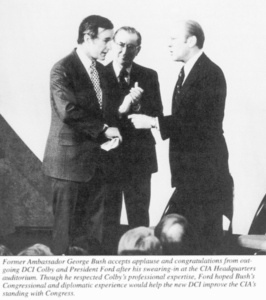
Former Director of Central Intelligence William Colby, then US President Gerald Ford and incoming DCI George Bush, circa 1975. - Bush established that ‘the CIA will not enter into any paid or contractual relationships with any full-time or part-time news correspondent accredited by any United States news service, newspaper, periodical, radio or television network or station’ (Slate, 2018).
- Although in 1976 Colby claimed that Central Intelligence had broken all relations and ties with journalists in 1973, this is hard to believe. Moreover, he also stated that he did not see any harm in purchasing information from ‘part-time correspondents who sell their information to news organisations in the country’ (Harrock, 1976).
- According to Harrock (1976), a general suspicion took over the Capitol City: all conservative journalists and former CIA employees that had rapidly achieved recognition within the news world were regarded with mistrust.
- The same year, Senator Church published in his report that the CIA had a strong network composed of ‘several hundred foreign individuals around the world’ that were dedicated to providing Central Intelligence with misleading news (Slate, 2018).
- In fact, American journalist Scott Shane (2018) gave an account of his experience with the CIA: in 1979, he received their recruitment letter in which they ‘expressed “tentative interest” in [his] qualifications’. Shane declined the offer of collaborating with the CIA, and his file was placed in the ‘inactive section’.
- According to Bernstein (1977), the people that worked undercover for the CIA were often employed by the ‘CBS, Time, the New York Times, the Louisville Courier-Journal, the Copley News Service, ABC, NBC, Reuters’, and so on. Moreover, throughout the 1950s, the CIA invested much money in training their agents as journalists: according to members of the CIA, they ‘were taught to make noises like reporters’ before being placed in powerful organisations.
- In essence, mass media is able to implement manipulative strategies in order to alter ‘global perception’ about events, people and situations (Washington, 2017; citing Davis 2008). Certainly, it would be naive to believe that the government has stopped paying journalists ‘to spread disinformation’. The United States are often the first to spread information in order to serve its own objectives: as Washington (2017) points out, ‘the government plants disinformation in American media in order to mislead foreigners’.

